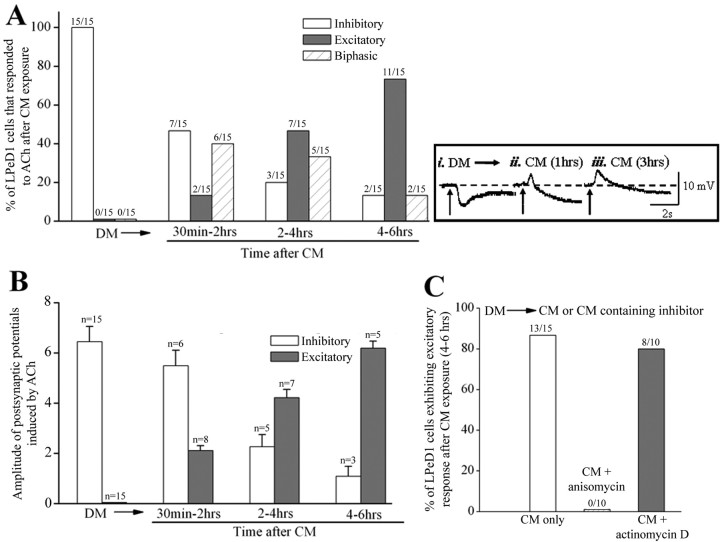Figure 6.
CM-induced new protein synthesis, but not gene transcription, is required for the expression of excitatory nAChRs. A, To determine the time required by CM to switch inhibitory response to appropriate excitatory response, LPeD1 cells were cultured overnight in DM. Intracellular recordings were made after 12–18 h of culture and ACh (1 μm) was applied exogenously to the somata of LPeD1 while neurons were impaled with intracellular sharp electrodes. It is important to note that ACh mimics both inhibitory and excitatory effects observed in LPeD1 neurons cultured in DM and CM respectively. Specifically, responses of LPeD1 cells to exogenously puffed ACh (1 μm) were tested both in DM and then after exposure to CM for 30 min, 2 h, 2–4 h and 4–6 h. We found that within 30–120 min of CM exposure, LPeD1 cells began to switch their inhibitory response to excitatory with there being the presence of an overlapping biphasic response. After 4–6 h of CM exposure, a large majority of the cells exhibited excitatory response (11 of 15 cells were purely excitatory, 2 of 15 cells were biphasic) indicating that the receptor responses had switched from inhibitory to excitatory. B, The amplitude of the inhibitory response gradually decreased with increasing excitation after CM exposure. Error bars indicate SE. Insets (top right, i, ii, iii) depicting A and B are sample traces obtained from LPeD1 cells exhibiting either inhibitory, excitatory or a biphasic response to ACh under various experimental conditions. The LPeD1 cell was held at −56 mV. Arrows indicate the application of ACh (1 μm). The dash line indicates the baseline of membrane potential. Note that cells that fired action potentials in response to ACh were only included in the percentage data but not in the amplitude measurements as these parameters are often difficult to discern from spiking neurons. Furthermore, the amplitude of both excitatory and inhibitory potential that was <0.5 mV was not included in the amplitude statistics. C, To determine whether a switch from inhibitory to excitatory receptor involved the synthesis of new receptors, cells cultured in DM were exposed to CM containing either transcription (actinomycin D, 1 μg/ml) or translation (anisomycin, 12.5 μg/ml) inhibitors for 4–6 h and cholinergic responses were tested electrophysiologically. We found that blocking protein synthesis but not the gene transcription blocked the CM-induced expression of excitatory receptors in LPeD1 cells.

